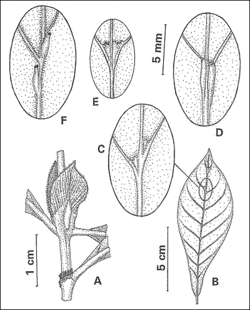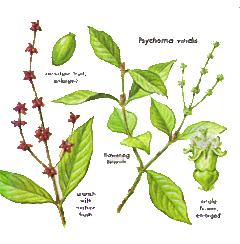- Psychotria viridis
-
Psychotria viridis 
Psychotria viridis with leaves clipped (clippings used for propagation) Scientific classification Kingdom: Plantae (unranked): Angiosperms (unranked): Eudicots (unranked): Asterids Order: Gentianales Family: Rubiaceae Genus: Psychotria Species: P. viridis Binomial name Psychotria viridis
Ruiz & Pav.Synonyms - Palicourea viridis (Ruiz & Pav.) Schult.
- Psychotria glomerata Kunth
- Psychotria microdesmia Oerst.
- Psychotria trispicata Griseb.
- Uragoga glomerata (Kunth) Kuntze
- Uragoga microdesmia (Oerst.) Kuntze
- Uragoga trispicata (Griseb.) Kuntze
- Uragoga viridis (Ruiz & Pav.) Kuntze[1]
- In parts of Ecuador, "Chacruna" is used to refer to Chaliponga, Diplopterys cabrerana, rather than P. viridis.
Psychotria viridis is a shrub from the coffee family, Rubiaceae. It has many local names, including Chacruna and Chacrona (from Quechua chaqruy, "to mix").
It is a close relative of the Ecuadorian Psychotria carthagensis, known as samiruka (amiruca), and some dispute remains as to whether or not the two are actually separate species.
Contents
Description
Psychotria viridis is a perennial bush which grows up to 5 m tall and 2 m wide.[2]
Stems
In the middle and lower parts of the stem, situated between the insertion points of the two opposite leaves there is a horizontal scar 0.3-1 mm wide that extends between the leaves (or leaf scars) and sometimes also connects over the tops of these scars, and along the top side of this scar there is a dense, usually furry line of fine trichomes (i.e., plant hairs) usually 0.5-1 mm long that are reddish brown when dried (Figure 4A). This combination of features is diagnostic for many species in the genus Psychotria, though not for any individual species [i.e., these features distinguish Psychotria L. Subg. Psychotria; other subgenera of Psychotria lack the well developed reddish brown trichomes inserted above the stipule scars]. On the upper stems of Psychotria viridis these features are obscured by a stipule (see below), which covers the trichomes; the scar actually marks the point where this structure has fallen off.
Stipules
These are leafy structures that cover and protect the young developing leaves, then fall off leaving scars on the stem. The stipules are produced in pairs, and their form is distinctive for Psychotria viridis: They are 5-25 x 4-12 mm, elliptic in outline, sharply angled at the apex, papery to membranaceous in texture, ciliate (i.e., fringed) along the upper margins, and longitudinally flanged or winged along the middle (Figure 4A). However, stipule shape and size is quite variable among different plants, and also depends on the stipule's developmental stage and other factors such as whether the stem that produced it is reproductive or vegetative.
Leaves
These (Figure 4B) are opposite in arrangement (i.e., produced in pairs along the stems), generally 5-15 x 2-6 cm, in outline generally elliptic or often widest above the middle, usually sharply angled at base and apex, papery in texture, overall smooth or infrequently with microscopic plant hairs on the lower surface, have 5-10 pairs of secondary veins, and on the lower surface usually have foveolae (see next item). The leaves are borne on petioles (i.e., leaf stalks) generally 1-10 mm long. When dry, the leaves of Psychotria viridis usually are gray or reddish brown. The leaves of Psychotria viridis are similar to a few other New World species of Psychotria.
Foveolae
These are small pockets found on the lower leaf surface near the junction of the secondary (i.e., side) veins with the central vein. They function as shelter for tiny invertebrates such as mites that live on the plant leaf. These mites apparently often are symbiotic with the plant, taking shelter in these structures and eating fungi and herbivorous invertebrates that can damage the leaf. The foveolae (also called domatia) are distinctive for Psychotria viridis and a few related species: They are generally 1.5-5 mm long and 0.5-1 mm wide at the top, conical and tapered to a closed base, open and truncate or variously ornamented at the top, and situated along the sides of the central vein with the opening usually near a secondary vein (Figure 4C). These foveolae vary in shape among different plants (Figure 4C, 4D, 4E, 4F), and in number on individual leaves, and may not even be present on some leaves. Most often each leaf bears at least one pair of foveolae, which may be close to the apex; the foveolae are often more numerous on leaves from vegetative stems than on those from reproductive stems.[3]
Cultivation
Cultivation from cuttings is easiest.[5] A single leaf (or even part of a leaf slightly covered with soil) can be sufficient for a cutting.[5] Propagation from seed is extremely difficult. The germination rate can be as low as 1%.[5] There are approximately 50 seeds/g.[4]
Uses
Medical
The Machiguenga people of Peru use juice from the leaves as eye drops to treat migraine headaches.[5]
Alkaloids
Dried Psychotria vidris contains about 0.10-0.66%[6] alkaloids. Approximately 99% of that is dimethyltryptamine (DMT). Other alkaloids such as beta-carbolines and NMT have been found. The alkaloid content is said to be highest in the morning.[5]
Entheogenic and religious
It contains the hallucinogenic—or entheogenic—indole alkaloid DMT (dimethyltryptamine) 0.1-0.61% dried mass.[7] It is known primarily as a principle admixture to the ayahuasca brew used in South and Central America. It is legal in Brazil where native tribes use it religiously.
Vegetalistas, healers in the Amazon regions of Peru, Ecuador and Colombia, recognize different sub-varieties of Psychotria viridis, based on the location of glands on the back of the leaves. The Brazilian ayhuasca church, Santo Daime, holds that Banisteriopsis caapi, the primary component of ayahuasca, provides "force" to the tea, whereas Psychotria viridis, or chacruna, provides "light".
This may not be far from the truth as the recognized mechanism of action is the combination of a monoamine oxidase inhibitor (MAOI) which allows ayahuasca to be effective in oral doses (unlike smoking DMT crystals which requires no conditioning partner drug).
See also
References
- ^ "Catalogue of Life : 2008 Annual Checklist : Psychotria viridis Ruiz & Pav.". www.catalogueoflife.org. http://www.catalogueoflife.org/show_species_details.php?record_id=4089042. Retrieved 2008-05-04.
- ^ "Psychotria VIRIDIS". 209.85.171.104. http://209.85.171.104/translate_c?hl=en&langpair=es%7Cen&u=http://psicodioscorides.com/p_39.htm. Retrieved 2008-05-04.
- ^ Psychotria Viridis - A Botanical Source of Dimethyltryptamine (DMT) - DEA Microgram Journal
- ^ a b "Psychotria viridis in Profile". www.b-and-t-world-seeds.com. http://www.b-and-t-world-seeds.com/391.htm. Retrieved 2008-05-08.
- ^ a b c d e Rätsch, Christian. Enzyklopädie der psychoaktiven Pflanzen. Botanik, Ethnopharmakologie und Anwendungen.. p. 15. ISBN 978-3855025701.
- ^ Psychotria viridis
- ^ Amazing Nature
External links
- Psychotria viridis Chacruna, the traditional Ayahuasca DMT source.
- Growing Psychotria viridis (Plot55.com)
- A General Introduction to Ayahuasca
Categories:- Ayahuasca
- Entheogens
- Herbal and fungal hallucinogens
- Medicinal plants
- Psychedelic tryptamine carriers
- Psychotria
Wikimedia Foundation. 2010.


